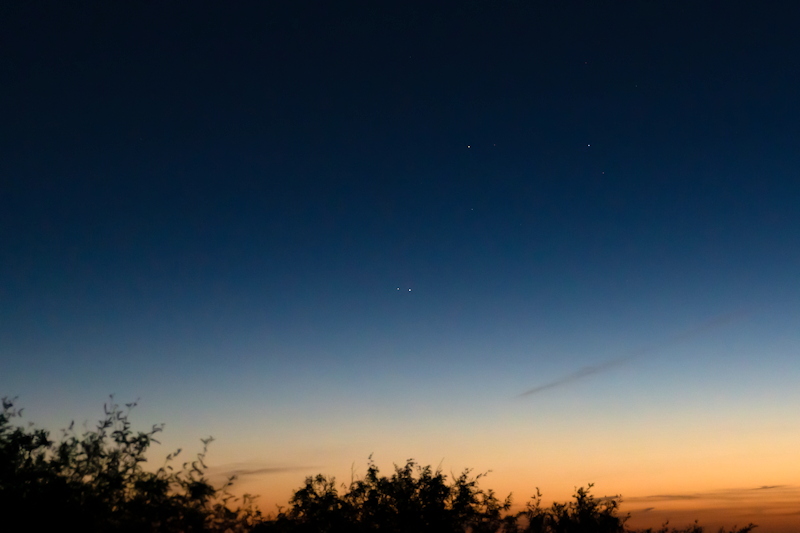Mars-Mercury Conjunction 27arcmin
Posted: 18 June 2019
Sunday, 16 June 2019, had been clear during the daytime with a clear sky forecast for the night. However, as sunset approached clouds were in most of the sky. Monday, 17 June, dawned overcast with a clear sky forecast for the night. The sky cleared mid-day.
|
Open: Monday, 17 June 2019, 1900 MST Temperature: 88°F |
Session: 1363 Conditions: Clear, breezy |
Equipment Used:
12" f/8 LX600 w/StarLock
2" 24mm UWA eyepiece
Camera:
D850 DSLR
1913 MST: LX600 ON, StarLock OFF, High Precision OFF.
1914 MST: slewed to the planet Mercury but it was not yet visible against the bright sky.
Prepared D850 DSLR for prime focus imaging.
1937 MST: sunset.
1938 MST: Mercury was now visible in the finderscope. Centered it and viewed Mercury, 102X. Its half-phase was easily seen. Mars was not yet visible although with this close conjunction with a separation of 27' (less than the diameter of the Full Moon) it would be in the same field-of-view as Mercury.
1943 MST: Mars and Mercury were now visible in the eyepiece, 102X. Mars showed a small disk. The close conjunction was neat to see.
Mounted the D850 DSLR at prime focus of the 12" telescope. This image taken at 1/800sec, ISO 1600, with North at the top, shows the planets Mars and Mercury. The insets show the planets magnified (although their low altitude in the sky made for poor images).

2003 MST: ended imaging of the planets, which were now too low for good imaging.
2005 MST: did some viewing of Mars and Mercury, 102X. A jet airliner crossed the field-of-view near Mercury. That would have been great to have captured with a camera.
2013 MST: Laurraine came out to view Mars and Mercury.
2015 MST: Mars and Mercury were now disappearing behind a tree as seen from the observatory.
I then viewed Jupiter, low in the southeastern sky and behind a tree, 102X. The four Galilean Moons were visible.
Ended the session due to a long day of activities the next day. Mars and Mercury will be even closer together Tuesday evening at 19arcmin.
2019 MST: LX600 OFF.
Stepped outside of the observatory for this photograph of the western sky showing how Mars and Mercury appeared in the sky (f/2.8, 1/15sec, ISO 3200, FL 46mm, slight crop):

Mouseover or tap on image for labels
|
Close: Monday, 17 June 2019, 2035 MST Temperature: 80°F |
Session Length: 1h 35m Conditions: Clear |
Comments are welcome using Email. Twitter users can use the button below to tweet this report to their followers. Thanks.
Cassiopeia Observatory Home Page
Copyright ©2019 Michael L. Weasner / mweasner@me.com
URL = http://www.weasner.com/co/Reports/2019/06/17/index.html
